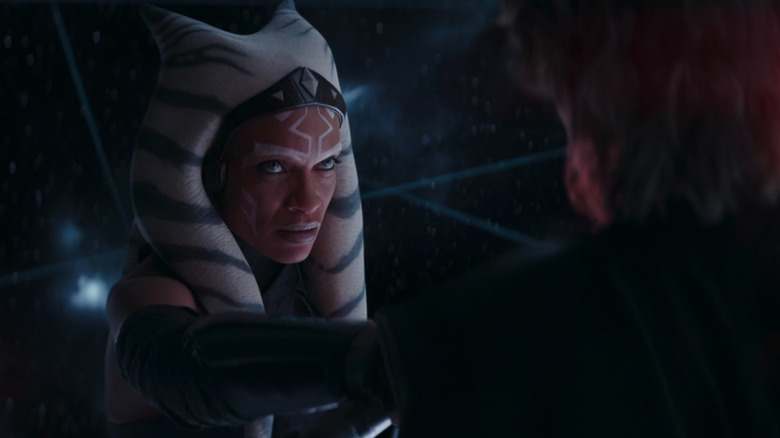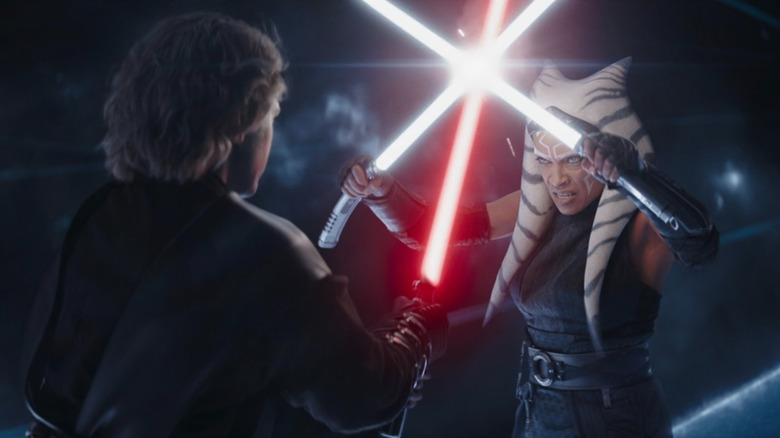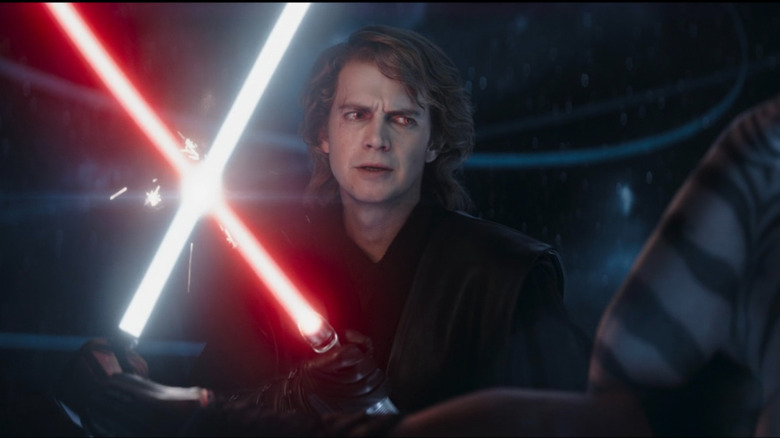Ahsoka's Force Experience In Episode 5 Differs From Luke And Rey's In One Big Way
This article contains spoilers for "Star Wars: Ahsoka" episode 5 — "Shadow Warrior."
The latest episode of "Ahsoka" had all the makings of a classic "Star Wars" story that could bridge the gap between the prequel trilogy, the animated series "Star Wars Rebels," and finally introduce the apparent heir to the Empire, Grand Admiral Thrawn (Lars Mikkelsen). Unfortunately, the fifth installment of the series, "Shadow Warrior," (read the /Film review here) felt a little anticlimactic, functioning as more of a mid-season finale to set up the inevitable clash between Ahsoka and Thrawn, and the long-awaited reunion with Ezra Bridger that caused Sabine to enter a shaky truce with Baylon Skoll and Morgan Elsbeth.
Surprisingly, "Shadow Warrior" chooses to draw parallels back to "The Empire Strikes Back" and "The Last Jedi" giving Ahsoka her own version of a Force trial, similar to the challenges that Luke experiences on Dagobah and Rey encounters on the remote planet of Ahch-To.
After the events of episode 4, "Fallen Jedi." Ahsoka finds herself on an ethereal plane somewhere in the Netherworld of the Force. Her old Master, Anakin Skywalker, is there waiting with open arms to help guide her. Once "Shadow Warrior" gets rolling, however, Anakin goes from a benevolent spirit to a dark shadow of his former self. Darth Vader begins to loom large over Ahsoka inside this newfangled spirit realm where Ani's former Padawan must confront her regrets from the past in order to return to the present and finish her quest to save her friends and ensure that a new era of the Empire never emerges.
To do that, Ahsoka must embark on her own personal journey through the Force that she never intended to confront. In contrast to Luke and Rey's rites of passage, Ahsoka has more of a near-death experience that puts her at peace long after she has become a Jedi.
Confronting your greatest fear
After the events of Order 66 in "Revenge of the Sith" and his battle with Darth Sidious in the Galactic Senate Chamber, Yoda chooses to exile himself to Dagobah for a reason when Luke first meets him in "The Empire Strikes Back." The remote swamp planet has an exceptional connection to the Dark Side of the Force, allowing Yoda to remain undetected. When Luke is told to wander down into the Cave of Evil, he sees a manifestation of his worst fear, defeating a vision of Vader only to find his own face staring back at him.
In "The Last Jedi," Rey also has to confront a strong Dark Side presence on Ahch-To. She is looking for answers about where she came from and who her parents are. Instead, in another instance of "Star Wars" poetry, Rey only sees her reflection. She is alone and finally accepts that stark fact.
For Ahsoka, her experience is entirely different and unsolicited. Instead of remaining unattached, she lets her friends and her unresolved grief about Anakin turning to the Dark Side get the best of her. As a result, she falls to her supposed death after battling Baylon Skoll on the cliffside of the planet Seatos. Ahsoka isn't seeking atonement, and her sentimental reunion with her fallen Master isn't really a lesson at all. It becomes a confrontation with what Anakin became, allowing her to finally come to terms with his tragic downfall in much the same way that Obi-Wan Kenobi was finally able to put his guilt to rest in his own, short-lived Disney+ series.
A grey area
In "Shadow Warrior," Anakin tells Ahsoka that it's time to complete her training. Instead, Ahoska's own memory sends her back to the Clone Wars and what appears to be the battle on Ryloth where she fights alongside her former Master. Flashes of Anakin blink back and forth between his time as a Jedi and his turn to the Dark Side where Vader and his red-bladed lightsaber start to emerge. What starts as a lightsaber battle that resembles more of a training exercise becomes a battle to the death that's more in tune with what we've seen in Ahsoka and Vader's epic fight in "Star Wars Rebels."
Anakin asks her whether she wants to live or die. She finally exclaims, "I choose to live," a decision that sends her hurtling back from the Netherworld of the Force into the land of the living. Ahsoka's unique connection with the Force allows her to experience a similar trial that certainly has obvious connections to Luke and Rey's journey without feeling like a retread.
"Ahsoka" continues to play with the established order of things while still being able to delve into the deeper layers of "Star Wars" mythology established in "Star Wars Rebels." After visiting her former Master in the Netherworld, Ahsoka can finally put the past to rest. The experience also allows her to develop her powers of psychotherapy, or the ability to tap into objects using the Force to gain insight into the past, present, and future. It's the same Force ability that Rey may have used when she touched Luke's lightsaber in "The Force Awakens."
The major difference between all three Force trials is the fact that Ahsoka was on the brink of death and never chose to walk down that particular path. That, perhaps, makes her even more special in the ways of the Force than previously thought.


